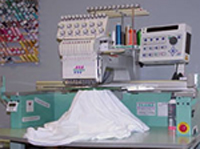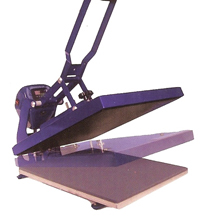Digitizing
DIGITIZING is the process of changing artwork into a ‘stitch’ file. The digitizer loads your image onto the computer and then creates your design using embroidery specific computer software. The software program is very complex and requires extensive training and practice to master. As with all software it is constantly being updated, demanding ongoing education. Digitizers will use the program tools to create stitches, trims, color changes, etc., eventually forming your image into a file that can be read by the computerized embroidery machine. This file is then transferred to the embroidery machine. The machine reads the information and lays down stitches in various shapes and colors, culminating in a beautifully crafted design.
Embroidery

The art of EMROIDERY is nearly as old as clothing itself. In the Middle Ages embroidery was often applied to religious vestments, but it also adorned luxurious garments and demanded high prices from the wealthy. Originally the craft was achieved by hand sewing thread designs onto fabric. Today embroidery machines are programmed to sew images created using computer software. Taking raw artwork and turning it into a ‘stitch file’ is known as digitizing. All images and text must be digitized before they can be sewn. Either rayon or polyester threads are used but only polyester can withstand bleaching. There is no limit to the number of colors that can be used.
The Heat Transfer Press

The HEAT TRANSFER Press process is achieved by press applying vinyl or ink transfers with a machine. The machine (heat press) uses temperatures of 325- 425 degrees F and requires sufficient pressure (usually 40-80 psi) to embed the design into the fabric.
Vinyl Transfers are commonly used in school sports to laminate names, numbers, and mascot images onto athletic wear and gear. The image is sent via computer to a cutting machine which scores the roll vinyl. The vinyl image is then peeled off the roll and placed on the garment. Together the garment and image are pressed for the appropriate amount of time. Multiple colors are possible but limited to 2 or 3 colors per design.
Ink Transfers are often used to add personal artwork or company logos to garments. An ink transfer is a special paper onto which an image is printed. Using the same process as with a vinyl transfer, the garment and printed paper are pressed together using the appropriate pressure, time, and temperature to embed the ink into the garment. Since these transfers have an indefinite shelf life they can be purchased in bulk and saved to apply at a moment’s notice, avoiding longer turn-around times of Embroidery and traditional Screen Printing.
Screen Printing
Screen Printing is a process which uses special inks pressed through screens onto fabric to create a design. The screens are made by stretching fine mesh (originally silk but currently polyester or stainless steel) tightly onto a frame. The design is then ‘burned’ into the screen using a liquid plastic coating and ultraviolet light. A separate screen is required for each color in the design. One color at a time, the ink is pressed onto the fabric with a short drying process between each color until the layered colors complete your design. The entire design then receives the final curing.